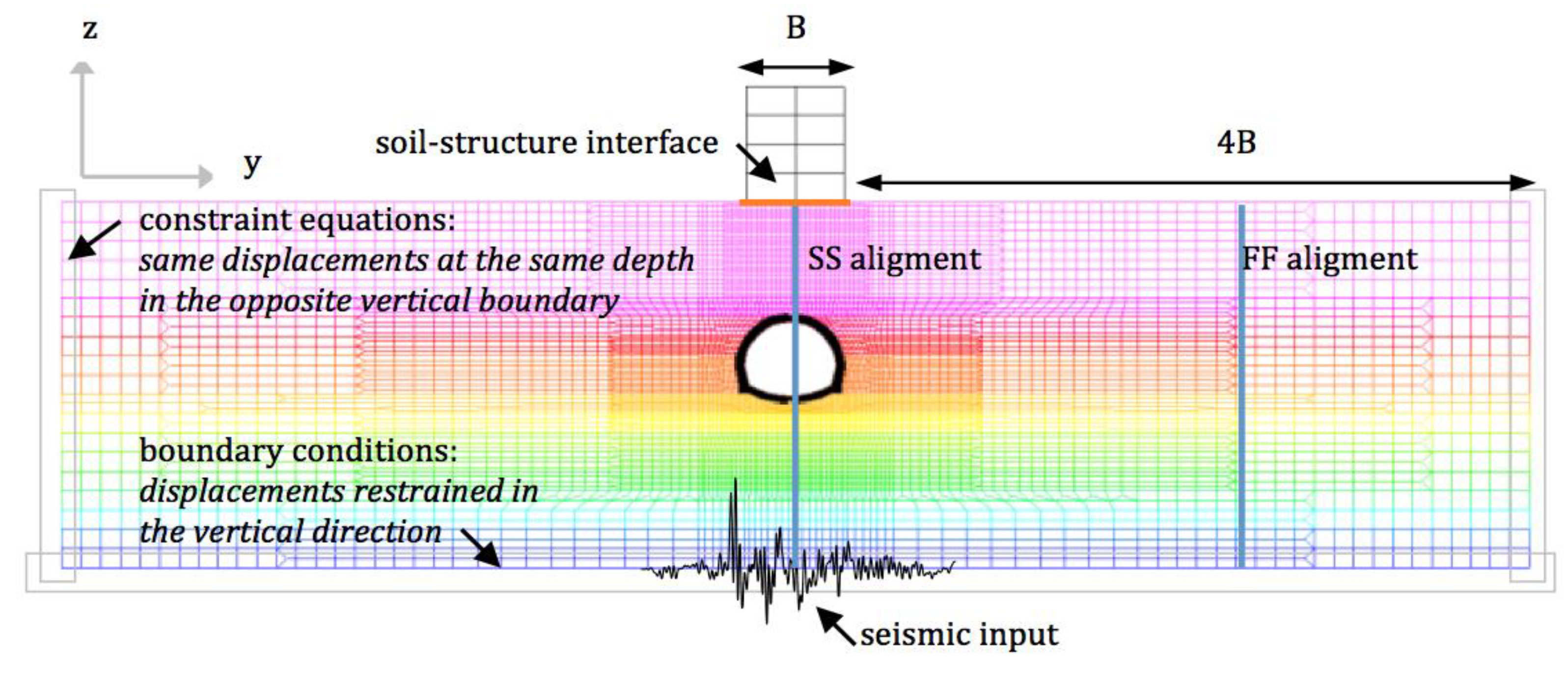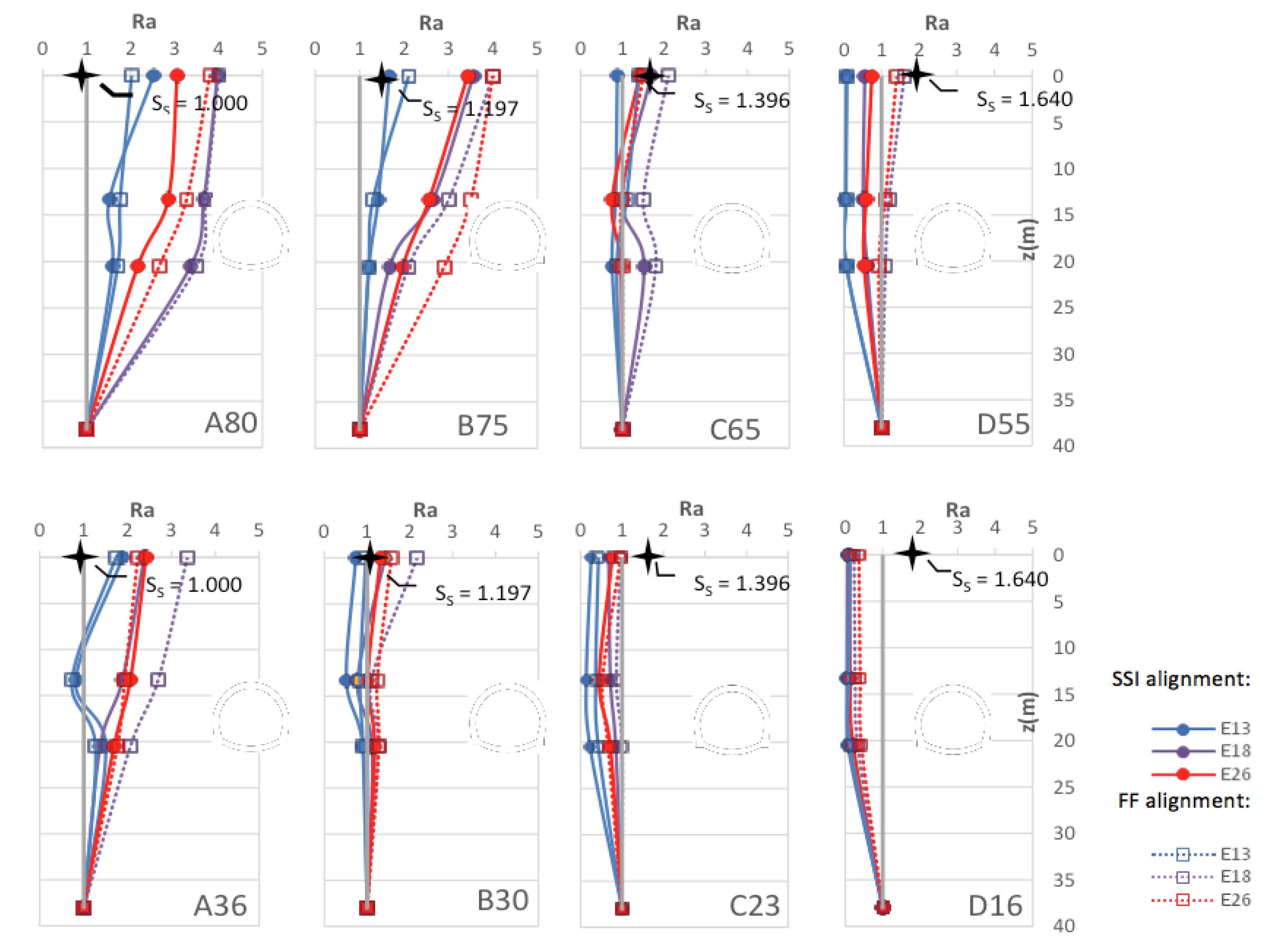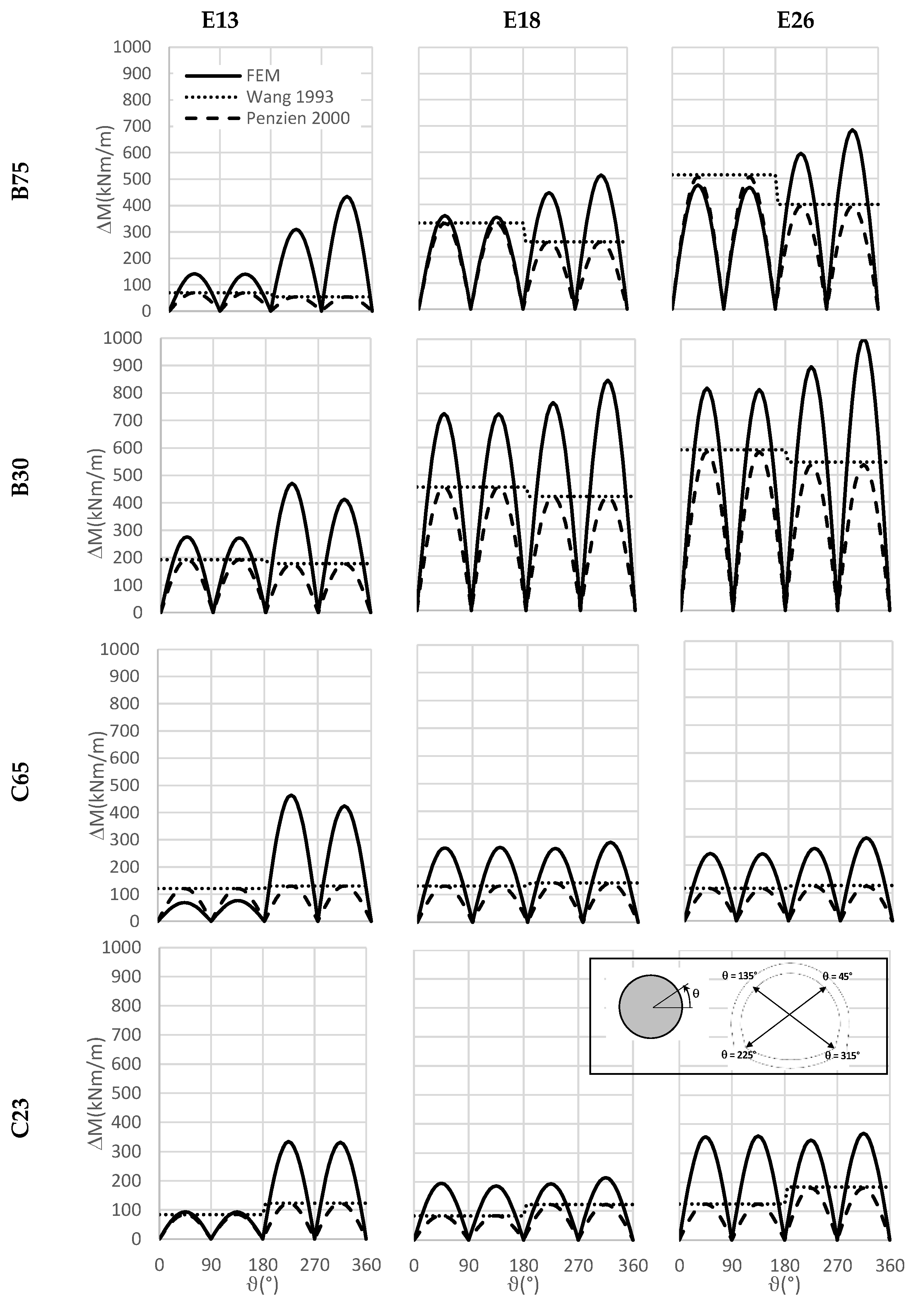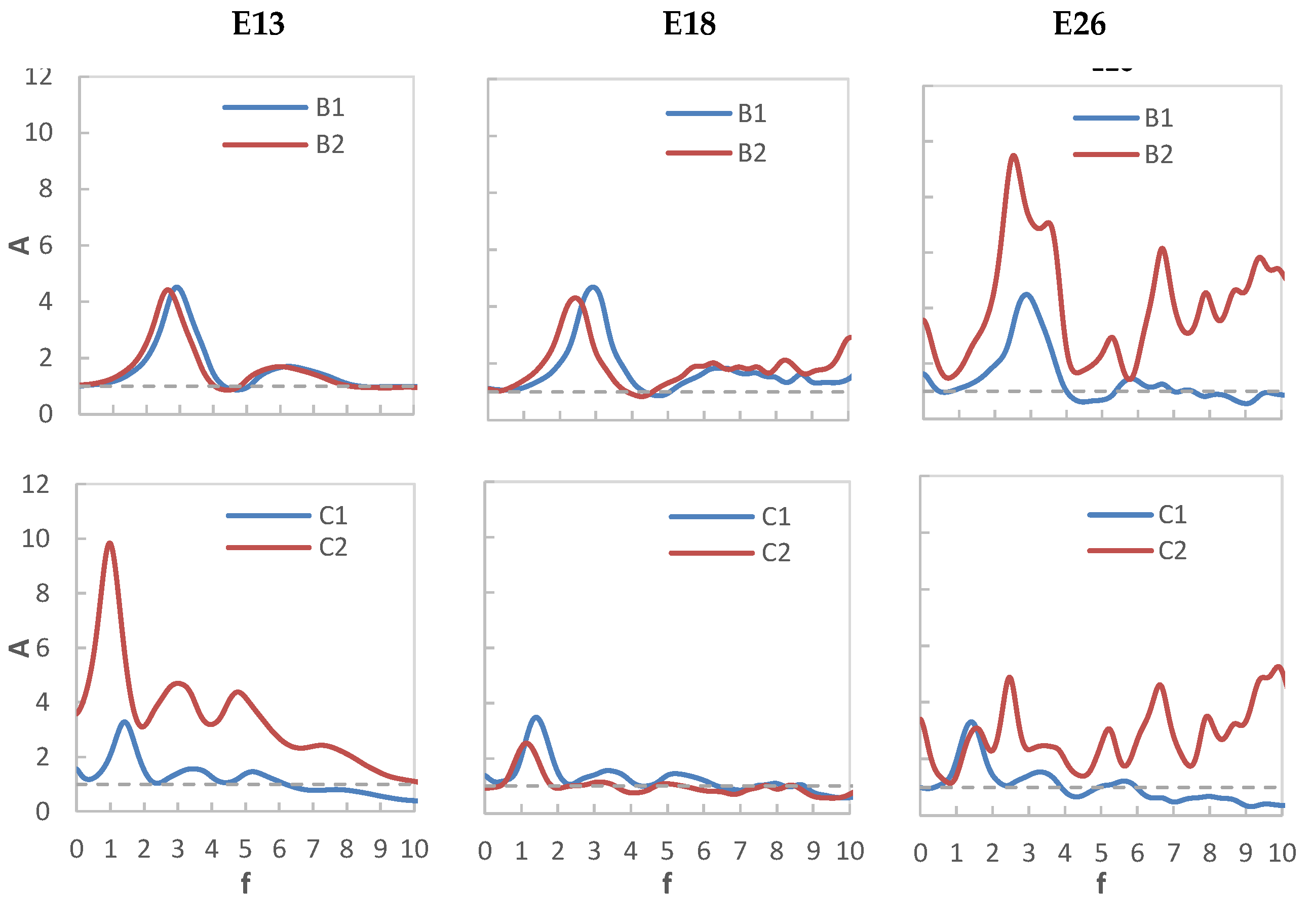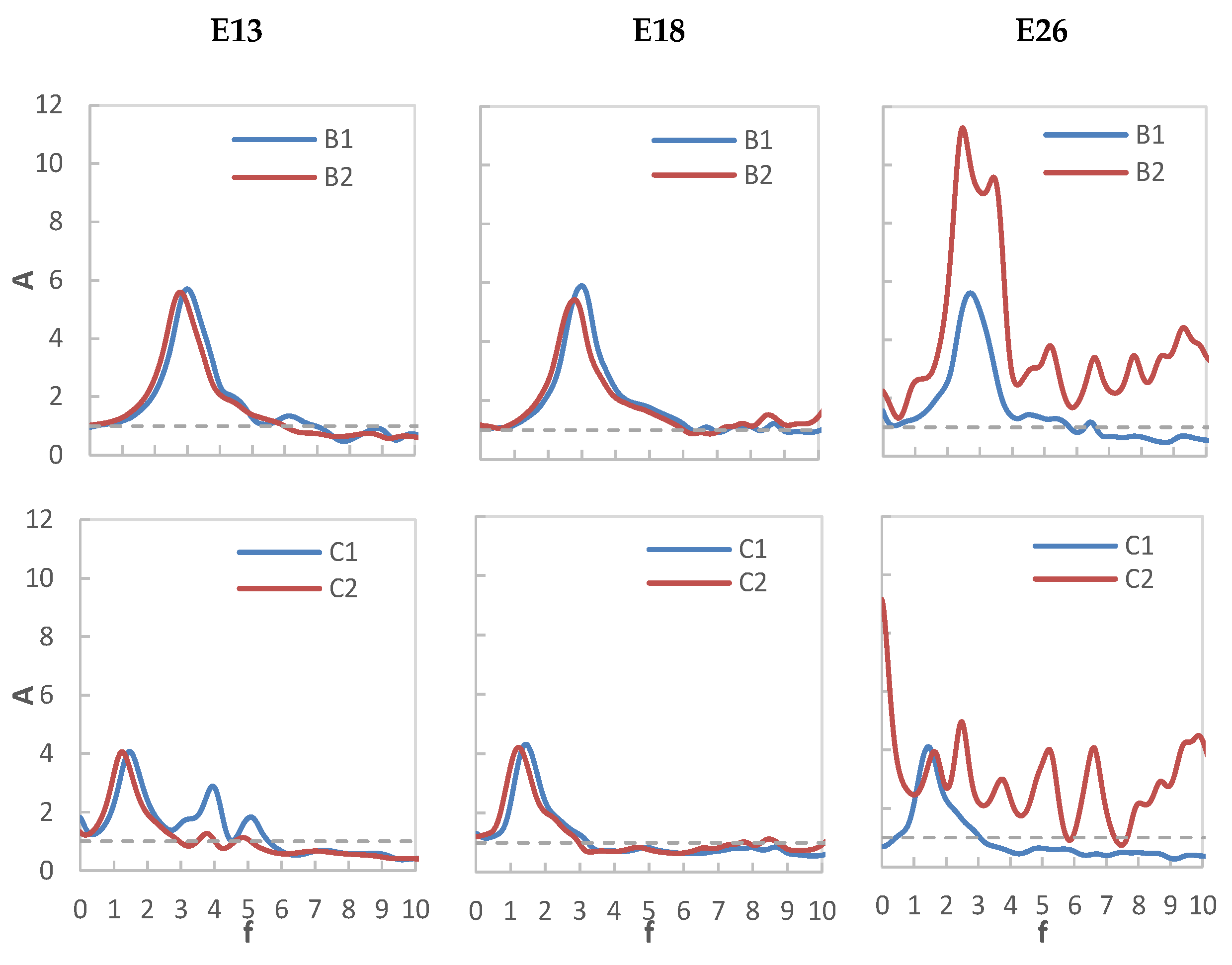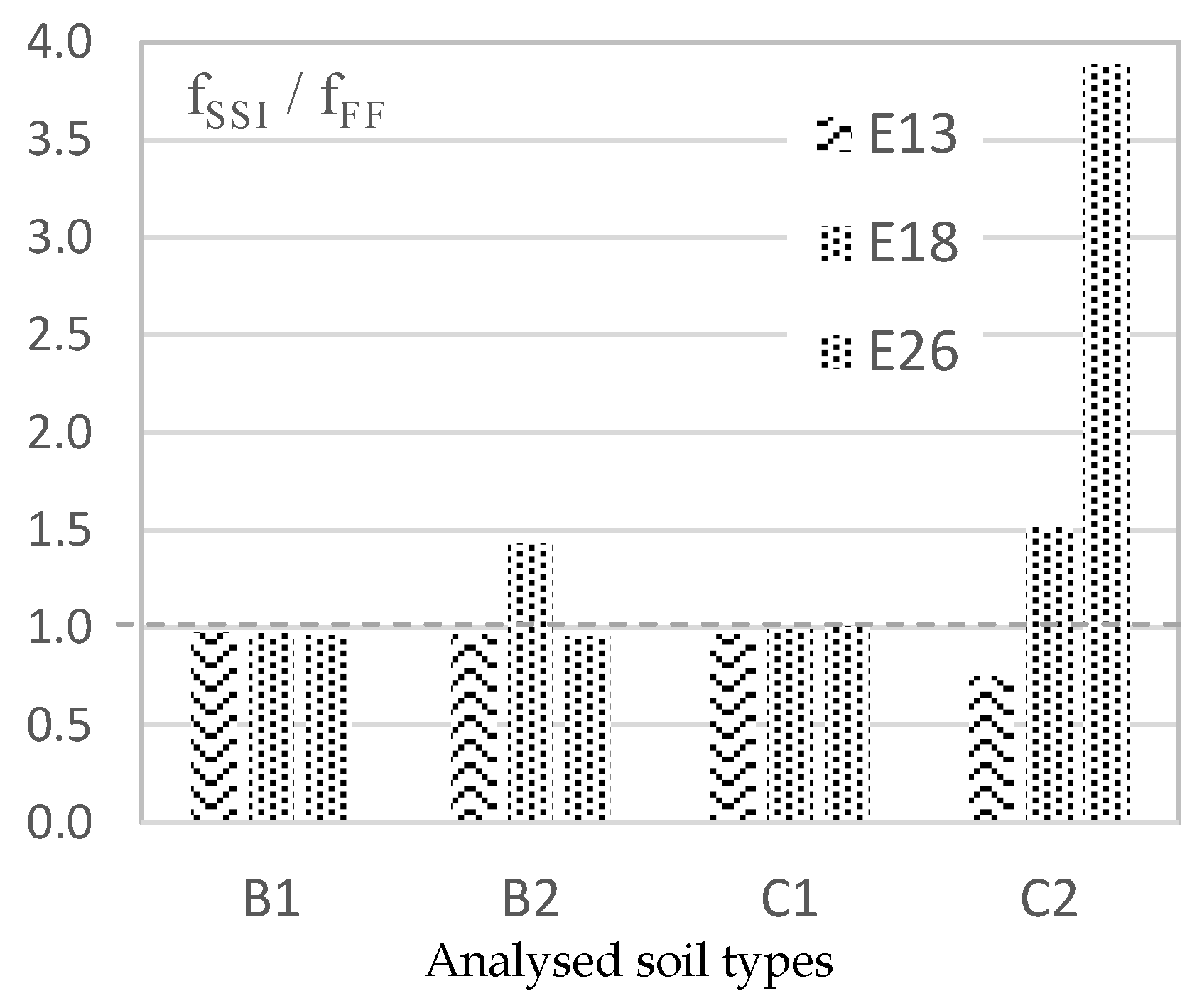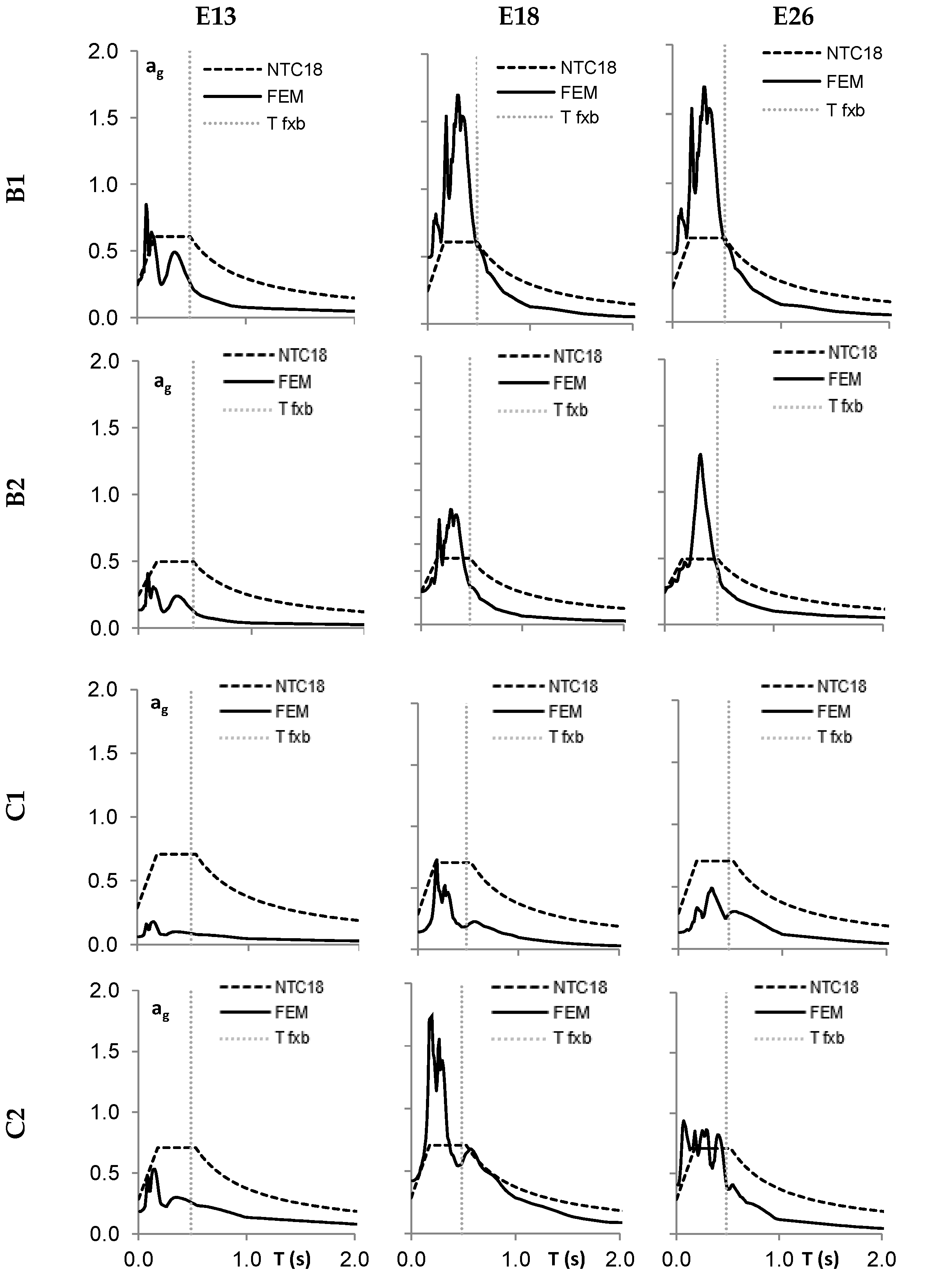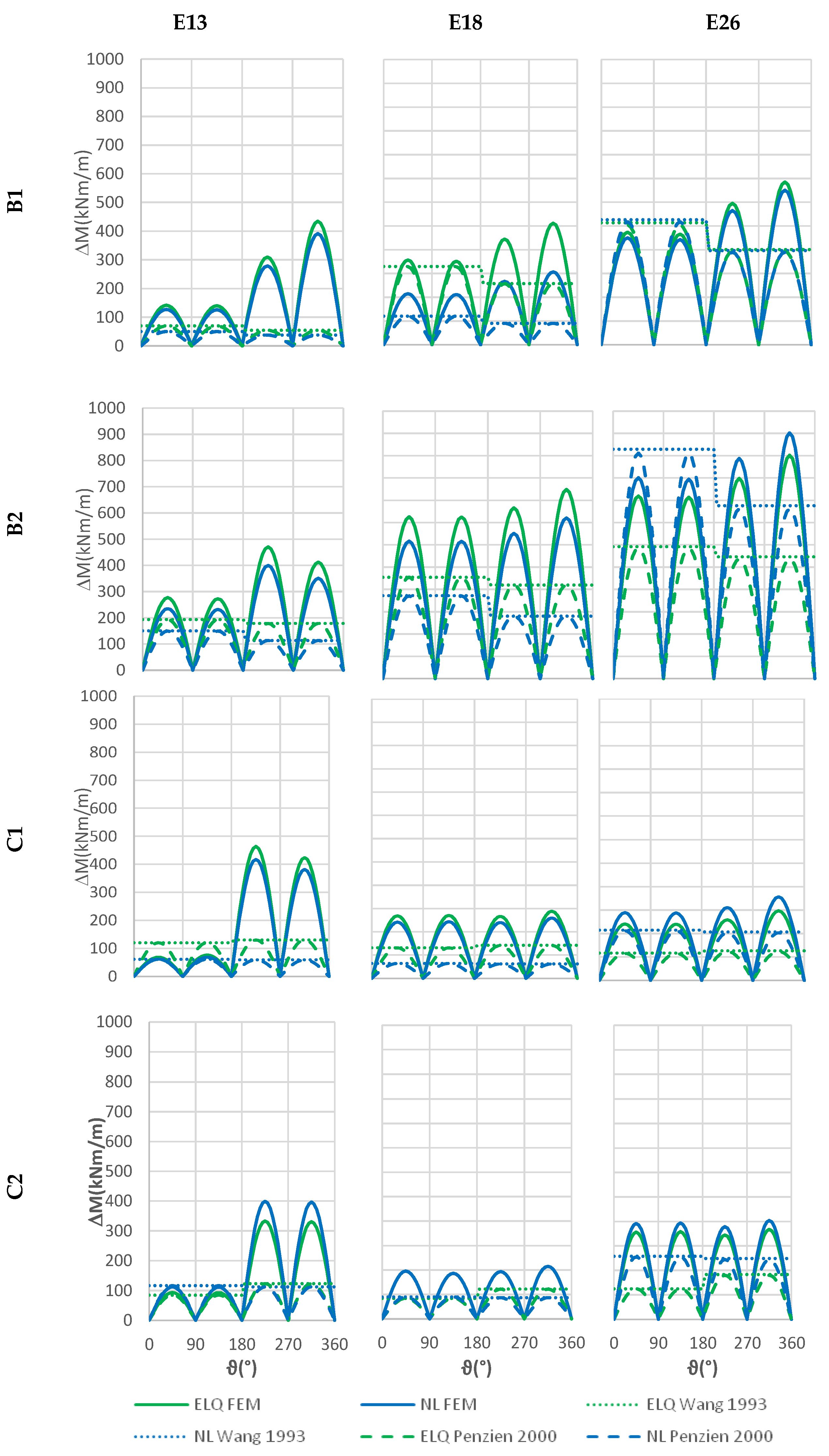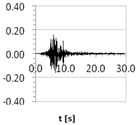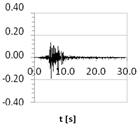1. Introduction
Currently, it is becoming ever more evident that there is a growing need for tunnels, in order to solve the problems faced by transportation and utility networks. In seismic areas, it is extremely important to assess the possible damage to the tunnel and to the aboveground structures as a result of earthquakes. Historically, tunnels have experienced a lower rate of damage than aboveground structures [
1]. Nevertheless, recent studies have documented significant damage suffered by tunnels due to seismic events [
2,
3,
4,
5,
6]. During an earthquake, the vibrations of aboveground structures may modify the dynamic response of tunnels [
7,
8]; at the same time, the presence of shallow tunnels may alter the response of aboveground structures. Most of the published papers consider only tunnel-soil systems [
9,
10,
11,
12,
13,
14,
15], while a few consider tunnel-soil-aboveground structure systems (TSS systems) [
16,
17,
18,
19,
20].
In TSS system behavior a fundamental role is played by dynamic soil parameters, and particularly by the shear wave velocity
VS and damping ratio
D of the soil through which the seismic waves move and which connects the tunnel to the aboveground structures. Currently, it is possible to accurately estimate
VS and
D directly or indirectly by means of a number of in-situ and/or laboratory tests [
21,
22,
23]. Nevertheless, given the considerable extension of tunnels, it is economically very expensive to accurately estimate these parameters for tunnels. This very often leads to unavoidable approximation in the evaluation of
VS profiles along the vertical and horizontal directions. It is then very interesting to investigate the effects of V
S and
D on the evaluation of the seismic response of TSS systems.
The present paper deals with parametric analyses performed by means of FEM modeling and involving a TSS system, with differing
VS profiles and
D, in order to underline the role of estimating these parameters. Using the case history of the underground network in Catania (Italy) and taking a cross-section including an aboveground building [
20], the real
VS profile [
21] was modified according to the four soil types reported by the Italian Technical Code [
24].
The analyses were performed in 2-D, considering the transversal direction of the tunnel, because the ovaling or racking deformations of tunnels are generally the most dangerous under seismic loading [
9,
25]. Isotropic visco-elastic-linear behavior was assumed for the tunnel and the aboveground structures. In order to take soil non-linearity into account, two different constitutive models were adopted for the soil: i) an equivalent linear visco-elastic model, characterized by degraded soil shear moduli
G and damping ratios
D, depending on the expected peak horizontal acceleration (PHA) at the ground surface according to suggestions given by [
26]; and ii) a visco-elasto-plastic constitutive model, characterized by isotropic and kinematic hardening and a non-associated flow rule [
27,
28]. Finally, three different seismic inputs were applied at the base of the models.
The seismic response of the TSS system was investigated in the time and frequency domains, in terms of: amplification ratios along the symmetry axis of the building and of the tunnel (SS alignment) and along a parallel alignment in free-field conditions (FF alignment); and bending moments in the tunnel. The latter were also compared with those obtained using the closed-form solutions by [
29] and [
30].
The paper highlights the importance of the investigation of Vs profiles in the study of the seismic response of TSS systems. Some interesting considerations on simplified versus sophisticated methods for taking into account soil nonlinearity have been developed.
2. The TSS System Investigated
The benchmark of the FEM analyses was a cross-section of the Catania (Italy) underground system actually under construction. The section includes an aboveground building (
Figure 1 and
Figure 2) [
20]. The geotechnical characterization of the soil, performed in two different phases (July 1999 and December 2005–January 2006), shows the soil profile reported in
Figure 1 and is characterized by a silty clay (ALg) and a clay (Aa) sub-lithotypes, which belong to the same lithotype, whose Young’s modulus
Es0 is constant for the first 10 m at a very small-strain and then increases linearly with depth (in the 300–1700 MPa range) and whose unit weight (
γ) is equal to 20 kN/m
3. No ground water table is present. Therefore, according to [
24], the soil can be classified as type C.
The cross-section is characterized by a reinforced concrete building 10 m wide, with two equal spans in the direction under investigation, and 12 m high, with four levels and shallow foundations, whose properties are: Eb = 28,500 MPa, νb= 0.2, γb = 25 kN/m3; and Db = 5%. The reinforced concrete tunnel is 11 m wide and 7.2 m high, with a horseshoe section, and it is located 18 m below the ground surface. Its properties are the same as the reinforced concrete building: E1 = 28,500 MPa, ν1 = 0.2, and Dl = 5%.
Using this case-history as a basis, different parametric analyses were carried out varying the
VS, choosing average values within the ranges provided by [
24] for the four types of soil classified as A, B, C, and D. The values adopted for
VS for each type of soil, as well as the corresponding stratigraphic amplification factor
SS provided by [
24] and evaluated for
Tr = 475 years, are shown in
Table 1.
7. Conclusions
The paper dealt with a case-history of the underground network in Catania (Italy) including an aboveground building. This case-history was previously investigated by the authors in order to detect the effects of the presence of: i. only the tunnel; ii. only the building; and iii. both the tunnel and the building. The results of this previous analysis are reported in [
20].
The aim of the present work was to study the effects of soil
VS profile and non-linearity on the full-coupled tunnel-soil-aboveground building system investigated in [
20]. The dynamic parameters of the soil and the seismic inputs at the bedrock were appropriately modified according to the classification of [
24], then different FEM models and therefore numerous parametric analyses were developed. As for soil nonlinearity, two different models were developed: the first group of analyses were conducted in an equivalent visco-linear elastic field according to suggestions given by [
24], i.e., degrading the soil shear modulus and damping ratio according to the expected PHA at the ground surface; the second group of analyses were conducted in the nonlinear field, by means of a visco-elasto-plastic constitutive model, characterized by isotropic and kinematic hardening and a non-associated flow rule. The three inputs used, labeled E13, E18, and E26, were scaled to two accelerations: 0.10 g and 0.30 g.
The results have been presented in terms of: acceleration amplification ratios, amplification functions, response spectra, and bending moments in the tunnels. A free-field alignment (FF) and an alignment crossing the tunnel and the aboveground structure (SS) were considered.
Initially, the results have been compared referring to the same constitutive model and varying the average Vs value and the seismic input. Finally, the results of the soil equivalent visco-linear elastic model were compared with those of the visco-elasto-plastic constitutive model.
As for the first comparison, relating to the different Vs of the analyzed soils, it was possible to observe that, first of all, the tunnel generally caused demagnification phenomena. Furthermore, the acceleration amplification ratios showed lower values in the cases of input accelerograms scaled to 0.3 g, mainly due to the required use of a high damping ratio (10%). Comparing the different soil types subjected to the same seismic input, it can be deduced that passing from soils with higher VS values to soils with lower VS values, a minor amplification of the signal occurred, contrary to what is foreseen by the Technical Codes. This behavior was due to a higher effect of the soil damping ratio and highlights the importance of a careful estimation of soil parameters and of specific local seismic response studies.
Comparing the amplification functions, the nonlinearity caused a shift of the amplification peaks towards smaller frequencies as well as an attenuation of the amplification peak.
Comparing the fundamental frequencies of the inputs (finput) and of the system (fSSI, obtained with reference to the SS alignment) the probable resonance phenomena were investigated: the E13 accelerogram had a high value of the finput/fSSI ratio and therefore no resonance phenomena could occur; the E18 accelerogram showed ratios that were not particularly high but which were higher than the unit value; finally, the E26 accelerogram could cause resonance phenomena, due to the proximity of finput to fSSI. Furthermore, through the comparison between the frequencies of the two FF and SS alignments examined it is clear that the influence of the structures was minimal.
In regards to the response spectra, it can be observed that neglecting a local seismic response study and considering the spectra provided by [
24] might be detrimental in some cases. In particular, for the cases under analysis, the spectrum provided by [
24] tended to be safer than the FEM ones for soils characterized by lower
VS values and concordant with the numerical ones or slightly detrimental for soils having higher
VS values.
As for the bending moments in the tunnel, the comparison between the FEM and analytical [
29,
30] results was satisfactory in the upper arc of the tunnel, instead in the lower arc of the tunnel the analytical methods led to an underestimation of the moments compared to those derived by FEM analyses.
Regarding to the comparison between the two adopted soil models, i.e., the equivalent visco-linear elastic model and the visco-elasto-plastic constitutive one, the main results were summarized in the following.
The amplification ratio had almost the same trend in both cases. In particular, in the case of accelerograms scaled to 0.1 g, slightly higher amplification ratios were achieved by the equivalent visco-linear analyses. Instead, in the case of accelerograms scaled to 0.3 g, the maximum values of the amplification ratios were obtained by the nonlinear analysis. The differences between the two constitutive models were however minimal and this makes it possible to affirm that the same soil filter effect was achieved by both models.
Comparing the amplification functions, the fundamental frequencies obtained by the equivalent linear visco-elastic model were slightly smaller than those obtained by the nonlinear model.
As for the response spectra, the spectral ordinates obtained by the two different constitutive models were comparable to each other. In addition, the bending moments in the tunnel achieved by the two different models were comparable to each other.
It can be deduced that for relatively low accelerations the use of a nonlinear constitutive model for the soil can be avoided, because it requires a higher computational cost, but it generally leads to very similar results to those obtainable by an equivalent linear elastic modeling, carried out by simply following the EC8 suggestions. Moreover, the use of a nonlinear analysis requires the determination of many parameters; it is therefore justified only in the presence of strong seismic inputs that lead to serious nonlinear phenomena in the soil. Results of these studies could be very useful to seismic microzonation [
48,
49,
50].

